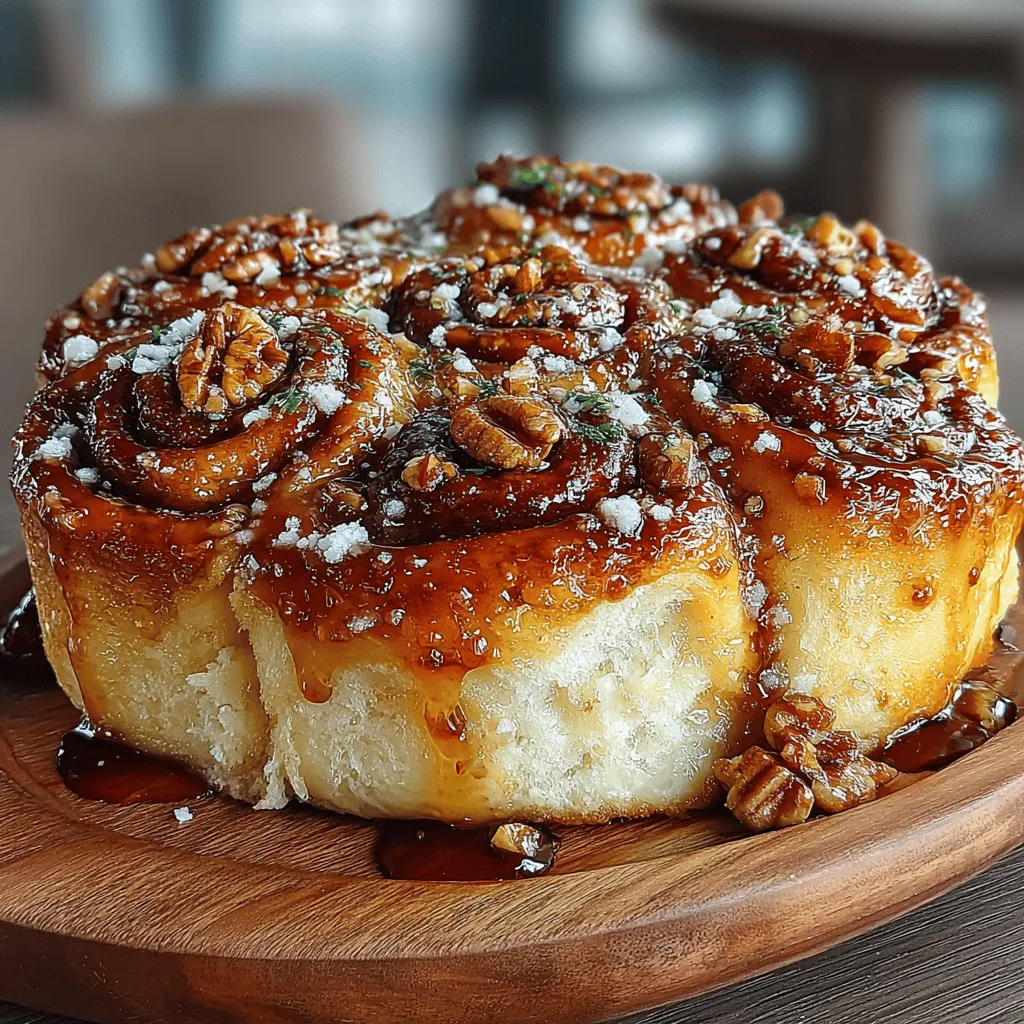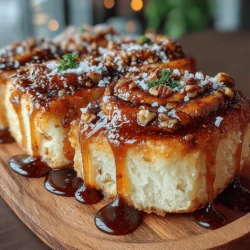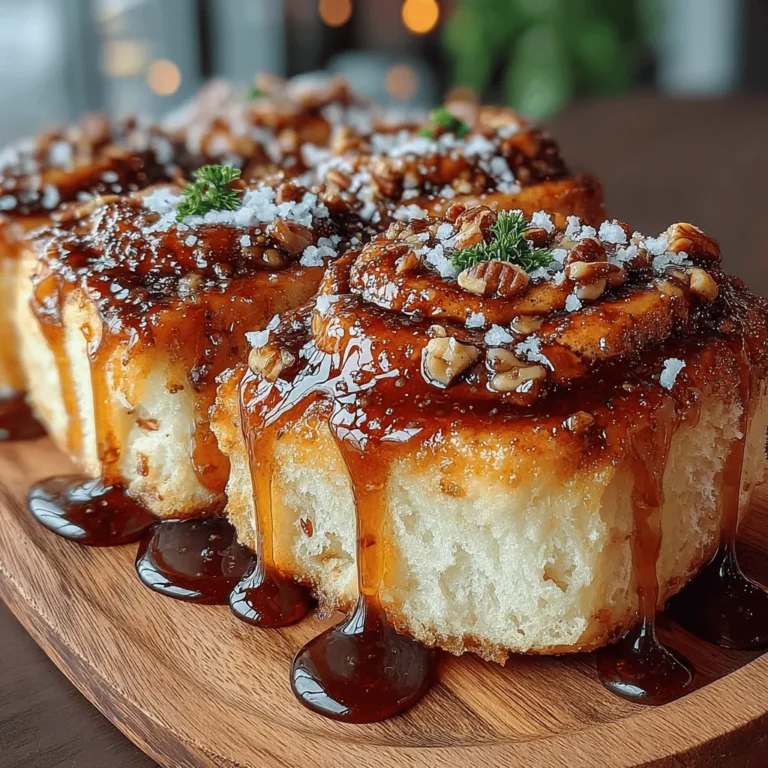Apple Cider Sticky Buns: A Cozy Fall Recipe
When the leaves begin to turn and the air fills with the crisp scent of autumn, there’s nothing quite like the comfort of fresh-baked sticky buns. Apple Cider Sticky Buns combine the rich, gooey sweetness of traditional sticky buns with the seasonal charm of apple cider, creating a delightful treat that’s perfect for cozy mornings or festive gatherings. This recipe offers a unique spin on a classic favorite, making it an ideal choice for those looking to embrace the flavors of fall.
Using seasonal ingredients like apple cider not only enhances the taste but also underscores the importance of cooking with what’s fresh and available. Apple cider, with its sweet and tangy notes, transforms an already delicious treat into something special, imbuing the dough with moisture and flavor that is simply irresistible. Whether served warm from the oven or enjoyed later in the day, these sticky buns are sure to please everyone at your table.
The Allure of Apple Cider Sticky Buns
Sticky buns have a long-standing place in the world of baking, often associated with comfort and indulgence. Their history can be traced back to German and American baking traditions, where they were frequently made for special occasions and family gatherings. The combination of sweet dough, sticky topping, and warm fillings has made them a beloved choice for brunch menus and holiday celebrations alike.
What sets Apple Cider Sticky Buns apart from their traditional counterparts is the addition of apple cider. This ingredient enhances not just the flavor but also the texture of the dough, making it soft and tender. The natural sweetness of apple cider complements the rich, buttery filling, creating a perfectly balanced treat that captures the essence of fall. As the weather cools down, the warmth of freshly baked sticky buns becomes a comforting experience that many look forward to.
Ingredients Breakdown
To create these delightful Apple Cider Sticky Buns, you will need a variety of ingredients that come together to create a fluffy dough, a flavorful filling, and a sticky topping. Here’s a detailed breakdown of what you’ll need:
Dough Ingredients
1. All-Purpose Flour: This is the backbone of your sticky buns. All-purpose flour provides the right structure and texture, ensuring your buns are soft yet hold their shape during baking.
2. Granulated Sugar: A small amount of sugar is essential for balancing sweetness in the dough. It not only flavors the buns but also helps activate the yeast, contributing to the dough’s rise.
3. Active Dry Yeast: The leavening agent in this recipe, active dry yeast is crucial for helping the dough rise and develop that fluffy texture we all love. Make sure your yeast is fresh for optimum results.
4. Salt: A key flavor enhancer, salt balances the sweetness of the sugar and is essential in strengthening the dough structure.
5. Ground Cinnamon: This warm spice is a quintessential ingredient in fall baking, adding a comforting aroma and flavor that pairs beautifully with apples.
6. Warm Apple Cider: The star ingredient of this recipe, warm apple cider not only adds moisture but also infuses the dough with a sweet, fruity flavor that complements the other ingredients perfectly.
7. Unsalted Butter: Butter contributes richness to the dough, ensuring that every bite is decadent and flavorful. Using unsalted butter allows you to control the salt levels in your recipe.
8. Eggs: Eggs provide structure and stability to the dough, helping it rise while adding to the overall richness.
Filling Ingredients
1. Brown Sugar: The foundation of the filling, brown sugar brings a deep, caramel-like sweetness that pairs wonderfully with the tartness of the apples.
2. Ground Cinnamon: Just like in the dough, cinnamon plays a key role in the filling, enhancing the overall flavor profile with its warm notes.
3. Chopped Apples: For the best flavor and texture, you can use a mix of apple varieties like Granny Smith and Honeycrisp. Granny Smith offers a tart contrast to the sweetness of the sugar, while Honeycrisp adds juiciness and a touch of honey-like sweetness.
4. Optional Nuts: Adding chopped pecans or walnuts can introduce a delightful crunch and additional flavor complexity to the filling.
Sticky Topping Ingredients
1. Brown Sugar: The base of the sticky topping, brown sugar will create that gooey texture that makes sticky buns so irresistible.
2. Butter: Like in the dough, butter is essential here, adding richness and helping to create that signature sticky sauce.
3. Apple Cider: Incorporating apple cider into the topping enhances the flavor and ties the entire recipe together, ensuring each bite is packed with autumnal goodness.
4. Vanilla Extract: A splash of vanilla extract adds depth and warmth to the sticky topping, rounding out the flavors beautifully.
Step-by-Step Cooking Instructions
Now that you have all your ingredients ready, it’s time to dive into the exciting process of making Apple Cider Sticky Buns. We’ll start with preparing the dough, which is the foundation of this delicious treat.
Preparing the Dough
1. Activate the Yeast: In a small bowl, combine the warm apple cider with a teaspoon of granulated sugar and the active dry yeast. Allow it to sit for about 5-10 minutes, or until it becomes frothy. This process is essential to ensure that your yeast is active and ready to help your dough rise.
2. Combine Dry Ingredients: In a large mixing bowl, whisk together the all-purpose flour, remaining granulated sugar, salt, and ground cinnamon. This dry mixture sets the stage for your dough, ensuring even distribution of flavors.
3. Mix Wet Ingredients: In another bowl, melt the unsalted butter and let it cool slightly. Once cooled, add the eggs and the activated yeast mixture, stirring until well combined.
4. Form the Dough: Gradually add the wet mixture into the dry ingredients, stirring until a shaggy dough begins to form. If the dough feels too sticky, you can add a little more flour, one tablespoon at a time, until it reaches a workable consistency.
5. Knead the Dough: Transfer the dough to a floured surface and knead it for about 5-7 minutes, or until it becomes smooth and elastic. This step is crucial for developing the gluten structure, which will give your sticky buns their desired texture.
6. First Rise: Place the kneaded dough in a greased bowl, cover it with a clean kitchen towel, and let it rise in a warm place for about 1 to 1.5 hours, or until it has doubled in size. This is the time to get excited as your dough transforms!
As the dough rises, you can begin preparing the filling and sticky topping, setting the stage for these delightful Apple Cider Sticky Buns to come together. Stay tuned for the next steps in this delicious journey, where we’ll assemble and bake these irresistible treats!

Importance of Correct Temperature for Yeast Activation
When making Apple Cider Sticky Buns, the temperature of your ingredients plays a crucial role in the success of your dough. Yeast is a living organism that thrives in warmth. Ideally, the water used for activating the yeast should be around 110°F (43°C). If the water is too hot, it can kill the yeast, while water that’s too cold will slow down the yeast’s activation process. To ensure optimal results, always use a kitchen thermometer to check the temperature. If you don’t have one, a good rule of thumb is to test the water with your wrist; it should feel warm but not hot.
Techniques for Combining Wet and Dry Ingredients
Combining wet and dry ingredients effectively sets the stage for a successful dough. Start by whisking your dry ingredients—flour, sugar, and salt—together in a large mixing bowl. In a separate bowl, combine your wet ingredients, including the warmed apple cider, melted butter, and eggs. Create a well in the center of your dry ingredients and pour the wet mixture into it.
Using a spatula or wooden spoon, gently mix until the dough begins to come together. Avoid overmixing at this stage; just ensure that all the flour is incorporated. This technique helps maintain the integrity of your dough, preventing it from becoming tough.
Kneading the Dough
Kneading is a fundamental step in bread-making that helps develop gluten, giving your sticky buns their desirable texture. Once your dough comes together, transfer it to a lightly floured surface and knead for about 8-10 minutes. Use the heel of your hand to push the dough away from you, fold it back over itself, and turn it a quarter turn—repeat this process.
You’ll know the dough is ready when it becomes smooth and elastic. A quick test is the “windowpane test”: take a small piece of dough and stretch it gently. If it can stretch without tearing and you can see light through it, you’ve achieved the right consistency.
Role of Kneading in Gluten Development
Kneading not only helps develop gluten but also enhances the overall structure of your sticky buns. Gluten provides the elasticity needed for the dough to rise properly, trapping the gases produced by the yeast. This results in a light and fluffy texture. Additionally, kneading helps distribute the yeast evenly throughout the dough, ensuring consistent rising and flavor development.
Crafting the Filling
While the dough rises, it’s time to prepare the filling for your sticky buns. In a bowl, combine brown sugar, cinnamon, finely chopped apples, and a pinch of nutmeg for added warmth. For a little extra moisture and flavor, consider adding a few tablespoons of melted butter.
Mix these ingredients until they are well blended. This filling will not only add sweetness but also enhance the apple flavor in each bite.
Tips for Evenly Spreading the Filling for Maximum Flavor in Every Bite
To ensure that every piece of your sticky bun is bursting with flavor, it’s crucial to spread the filling evenly over the rolled-out dough. After your dough has risen and is rolled out into a rectangle, use an offset spatula or the back of a spoon to spread the filling evenly. Start from the center and work your way to the edges, leaving about an inch border to prevent the filling from spilling out while rolling.
Rolling and Cutting the Dough
Once the filling is spread evenly, it’s time to roll the dough into a log. Start at one edge of the rectangle and roll it tightly towards the opposite edge. Try to maintain an even pressure to avoid any gaps in the filling. Once you have a tight log, use a sharp knife or dental floss to cut the log into equal pieces, about 1.5 inches thick.
For uniform pieces, consider measuring with a ruler. This will not only ensure even baking but also create a visually appealing presentation.
Creating the Sticky Topping
The sticky topping is what transforms your buns from delicious to irresistible. In a saucepan, combine brown sugar, butter, and a splash of apple cider. Heat over medium heat, stirring gently until the mixture is smooth and the sugar has dissolved.
Be careful not to let it boil for too long as this can cause the sugar to crystallize, resulting in a grainy texture. The key is to achieve a velvety consistency that will coat the buns perfectly.
Importance of Careful Heating to Achieve a Smooth Consistency
Achieving the right consistency in your sticky topping is essential for the final product. If your mixture becomes too thick, you can add a bit more apple cider to loosen it up. Conversely, if it’s too thin, allow it to cook a little longer while stirring. The goal is a thick syrup that will caramelize slightly as the buns bake, creating a delightful sticky glaze.
Second Rise: Why It Matters
After cutting your buns, allow them to undergo a second rise. This step is crucial as it develops the flavor and texture further. Cover the pan with a clean kitchen towel and let the buns rise in a warm area for about 30-45 minutes.
This additional rise allows the yeast to produce more gases, resulting in a lighter and fluffier texture. Skipping this step could lead to denser buns that lack the desirable fluffy quality.
Explanation of the Additional Rise and Its Impact on Texture
During the second rise, the dough continues to expand, and the yeast ferments further, enhancing the flavor profile. This process also allows the gluten to relax, making it easier for the buns to rise in the oven. The result is a tender, airy texture that makes each bite of your Apple Cider Sticky Buns a delight.
Baking the Sticky Buns
When your sticky buns have completed their second rise, it’s time to bake. Preheat your oven to 350°F (175°C). Bake the buns for 25-30 minutes or until they are golden brown and puffed up.
To ensure perfect baking results, keep an eye on the color of the tops. They should turn a deep golden brown, and a toothpick inserted into the center should come out clean. If the tops brown too quickly, consider covering them loosely with aluminum foil.
Signs to Look for to Ensure Perfect Baking Results
Perfectly baked sticky buns should be fluffy and golden on top while the sticky topping should bubble at the edges. You can also gently press the center of a bun; if it springs back, they are done. If not, give them a few extra minutes in the oven while checking frequently.
Serving Suggestions
Once your buns are baked to perfection, allow them to cool in the pan for about 10 minutes. This cooling period helps the sticky topping set a bit, making them easier to invert.
To serve, carefully invert the pan onto a serving plate, letting the sticky topping drizzle over the buns. For an extra touch, consider garnishing with chopped nuts or a sprinkle of sea salt to enhance the sweetness.
Ideas for Garnishing with Additional Sticky Topping
If your family or friends are fans of rich flavors, drizzle additional sticky topping over the buns right before serving. This not only adds to the visual appeal but also amps up the flavor. A dusting of powdered sugar can also provide a beautiful contrast against the golden buns.
Suggestions for Pairing (Coffee, Tea, or Milk)
Apple Cider Sticky Buns pair beautifully with a variety of beverages. For a warm and comforting breakfast or brunch, serve them alongside a steaming cup of coffee or a spiced chai tea. If you prefer something lighter, a glass of cold milk is always a classic choice that complements the sweetness of the buns.
Nutritional Information
For those who are health-conscious, understanding the nutritional content of your Apple Cider Sticky Buns can be helpful. A typical serving (one sticky bun) contains approximately 300-350 calories, 15-20 grams of fat, and 20-25 grams of sugar.
Discussion on Portion Sizes and Serving Suggestions
Keep in mind that these buns are rich and satisfying, so one or two per serving is usually sufficient. They can also be frozen for later enjoyment, which makes them an excellent make-ahead option for gatherings or busy mornings.
Conclusion
Making Apple Cider Sticky Buns is not just about enjoying a delicious treat; it’s about creating cherished memories with loved ones during the fall season. The process involves a delightful blend of techniques, from activating yeast to crafting the perfect sticky topping.
As you pull these warm, fragrant buns from the oven, take a moment to appreciate the effort and love that went into making them. With each bite, you’re not only experiencing a burst of flavor but also the joy of seasonal baking. Embrace this opportunity to create lasting memories with family and friends, and consider these sticky buns as a cherished recipe that will be passed down through generations. Whether enjoyed at breakfast, brunch, or as a sweet snack, these Apple Cider Sticky Buns are sure to become a beloved favorite in your home.


